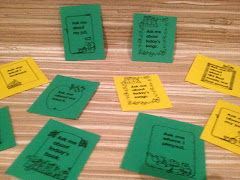Model Gratitude
Make it a habit to include things you appreciate into daily conversations.
Brainstorm
What does it mean to be thankful? Write children’s responses on the board. What are some synonyms for thankful?
Gratitude Journal
Make a special journal for each child to use during the month of November. Several times a week ask them to draw, list, or write sentences about things they are grateful for.
*I used copy paper and wallpaper cut in 9” x 12” rectangles to make my journal. Take five sheets of paper and fold in half. Center on the wallpaper and sew down the middle. (You can do this by hand, or maybe there is a parent or grandparent with a machine who would do this for you.) It makes a lovely book.


Thankful Board
Designate a bulletin board or poster in the hall as your “thankful board.” Children can attach sticky notes or draw pictures of things they are thankful for throughout the month.

Gratitude Box
Cut a hole in the top of a shoebox and decorate. Place on a shelf along with paper and pencils. Children write things they are thankful for and place them in the box. When you have a few extra minutes, select notes and read them to the class.
Lists
Children love to make lists, so let them make a list (draw pictures or write) of all the things they are grateful for.
ABC
Can they think of something for each letter of the alphabet that they are grateful for?

Count Your Blessings
Start the day by going around the room and asking each child to say something they are thankful for.
End with Something GOOD
Clap and slap thighs as you say this chant to end your day:
Hey, hey, what do you say?
What happened good at school today?
Hot Potato Pass
Children sit or stand in a circle and begin passing the hot potato (ball or other small object) around. When the music stops or when the teacher blows a whistle the child holding the potato must say one thing they are thankful for.
Charity
Find a project in your community that your class can do to help others. There are lots of good sites where you're sure to find something just right for your class this season,
blog.reallygoodstuff.com/12-community-service-projects-for-kids/
kidworldcitizen.org
















































